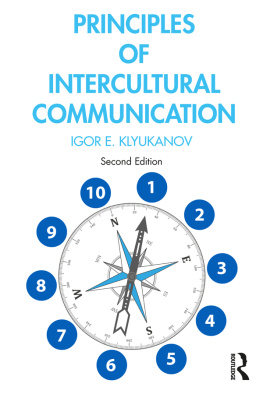An Introduction to Intercultural Communication
10th Edition
An Introduction to Intercultural Communication
Identities in a Global Community
10th Edition
- Los Angeles
- London
- New Delhi
- Singapore
- Washington DC
- Boston
SAGE Publications Inc.
2455 Teller Road
Thousand Oaks, California 91320
SAGE Publications Ltd
1 Oliver's Yard
55 City Road
London EC1Y 1SP
SAGE Publications India Pvt Ltd
B 1/I 1 Mohan Cooperative Industrial Area
Mathura Road
New Delhi 110 044
SAGE Publications Asia-Pacific Pte. Ltd.
18 Cross Street #10-10/11/12
China Square Central
Singapore 048423
Acquisitions Editor: Lily Norton
Editorial Assistant: Sarah Wilson
Content Development Editor: Jennifer Jovin-Bernstein
Production Editor: Tracy Buyan
Copy Editor: Melinda Masson
Typesetter: Cenveo Publisher Services
Proofreader: Victoria Reed-Castro
Cover Designer: Scott Van Atta
Marketing Manager: Staci Wittek
Copyright 2021 by SAGE Publications, Inc.
All rights reserved. Except as permitted by U.S. copyright law, no part of this work may be reproduced or distributed in any form or by any means, or stored in a database or retrieval system, without permission in writing from the publisher.
All third-party trademarks referenced or depicted herein are included solely for the purpose of illustration and are the property of their respective owners. Reference to these trademarks in no way indicates any relationship with, or endorsement by, the trademark owner.
Printed in Canada
This book is printed on acid-free paper.
20 21 22 23 24 10 9 8 7 6 5 4 3 2 1
Library of Congress Cataloging-in-Publication Data
Names: Jandt, Fred Edmund, author.
Title: An introduction to intercultural communication : identities in a global community / Fred E. Jandt.
Description: Tenth Edition. | Thousand Oaks : SAGE Publications, 2020. Revised edition of the authors An introduction to intercultural communication, [2018] | Includes bibliographical references and index.
Identifiers: LCCN 2020003602 | ISBN 9781544383866 (paperback) | ISBN 9781544383873 (epub) | ISBN 9781544383880 (epub) | ISBN 9781544383897 (Adobe pdf)
Subjects: LCSH: Intercultural communication. | Intercultural communicationUnited States. | Communication, International.
Classification: LCC GN345 .J43 2020 | DDC 303.48/2dc23 LC record available at https://lccn.loc.gov/2020003602
Detailed Contents
Detailed Contents
Pages
Preface
Why Study Intercultural Communication?
When a student asks, What is this class about? I have two answers. If its a short hallway conversation, I say something like to learn to become a more effective communicator with peoples of diverse cultural backgrounds. If we have time for a sit-down discussion, I start by talking about identitiesthe identities each of us accepts to be known by in the world. We then discuss what goes with those identitieseverything from what we wear, to the language we speak, to the values we use to guide our behavior. It then becomes obvious that diverse identities can be at the root of many communication barriers. At this point, students see the broader challenges and raise the issues of immigration, treatment of women, clash of religions and terrorism, corporate influence over local cultures, and countries exerting unwelcome influence over other countries.
In order to live, work, and play in an increasingly interconnected and interdependent world, we all need to communicate effectively with people of diverse cultural backgrounds. We need to be aware of how our language and nonverbal communications might be understood by people whose frame of reference is different than ours. We also need to understand how the historical relationships between cultures inform how they interact today. The aim of this book is to equip students with the knowledge and skills to be competent and confident intercultural communicators. In each chapter, the book guides students through key concepts and helps readers connect intercultural competence to their own life experiences in order to increase understanding.
The core objectives of this book have not changed with the 10th edition: I continue to promote the skills of intercultural competence by developing an understanding of cultures to better appreciate the opportunities and challenges each culture presents to its people, developing a better understanding of how people become who they are, becoming less threatened by those of different backgrounds, and becoming better able to select and perform communication behaviors appropriate to various settings.
What I strive to do is to provide information that is balanced and up-to-date in a manner that is accessible and interesting. It has been my objective from the first edition of this book to make it readable, engaging, and thought provoking while at the same time flexible enough to support individual instructors approaches to the content theories.












